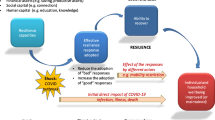Abstract
The objectives of this research are to investigate resource loss effects from flooding and to provide recommendations on disaster risk reduction policies. This research utilized a dynamic computable general equilibrium (CGE) model, which found that losses of resources had major negative impacts on real gross domestic product (GDP). Transitioning from national catastrophe insurance fund to an international risk pooling approach is discussed, and as the Global Catastrophe Risk Insurance Facility has not yet been established, our proposal suggests the Association of Southeast Asian Nations plus three (ASEAN + 3) Catastrophe Risk Insurance Facility (ACRIF) and the Association of Southeast Asian Nations plus three catastrophic bonds (ASEAN + 3 CAT bonds) as effective means of reducing fiscal liabilities arising from natural disasters, also effectively enhancing disaster risk reduction. These tools are complementary to Catastrophe Risk Swaps which are innovative global financial adaptation strategies designed to make communities and governments more resilient to disaster damages. They are ex-ante risk financing tools and sources of liquidity for damage restoration and economic recovery, which facilitates flexibility among the Association of Southeast Asian Nations plus three (ASEAN + 3) and other governments requiring special assistance. Most importantly, utilization of insurance and catastrophic bonds promotes the achievement of set objectives of global adaptation strategies, sustainable economic growth, and climate resilient development.


Similar content being viewed by others
Notes
The Department of Disaster Prevention and Mitigation will announce a disaster once 50 households have been damaged or floods have occurred for 15 days.
The compulsory purchase of insurance and fire insurance for households has been beneficial in building an information database in purchasing insurance, which could be used for other insurance businesses.
References
Abe S, Thangavelu SM (2012) Natural disasters and Asia. Asian Economic Journal 26(3):181–187. doi:10.1111/j.1467-8381.2012.02081.x
Asian Development Bank (2009) Natural catastrophe risk insurance mechanisms for Asia and the Pacific. Asian Development Bank, Manduluyong City, Philippines
Centre for NTS Studies (2010) The implementation of a disaster management agreement in ASEAN: towards regional preparedness? The S. Rajaratnam School of International Studies, Singapore
Centre of Policy Studies (2010a) Maintenance manual of MyAGE: a dynamic CGE model of the Malaysian economy. Centre of Policy Studies, Monash University, Melbourne
Centre of Policy Studies (2010b) Operation manual of MyAGE: a dynamic CGE model of the Malaysian economy. Centre of Policy Studies, Monash University, Melbourne
Centre of Policy Studies (2010c) Theoretical manual of MyAGE: a dynamic CGE model of the Malaysian economy. Centre of Policy Studies, Monash University, Melbourne
Cummins JD, Mahul O (2009) Catastrophe risk financing in developing countries: principles for public intervention. The World Bank, Washington, D. C., http://siteresources.worldbank.org/FINANCIALSECTOR/Resources/CATRISKbook.pdf
Department of Disaster Prevention and Mitigation (2006) Report on regional establishment of the ASEAN coordinating center for humanitarian assistance. Department of Disaster Prevention and Mitigation, Bangkok
Dixon PB, Rimmer MT (2002) Dynamic general equilibrium modelling for forecasting and policy: a practical guide and documentation of MONASH. North-Holland Publishing Company, Amsterdam
Giesecke JA, Burns WJ, Barrett A et al (2012) Assessment of the regional economic impacts of catastrophic events: CGE analysis of resource loss and behavioral effects of an RDD attack scenario. Risk Analysis 32(4):583–600. doi:10.1111/j.1539-6924.2010.01567.x
Hayashi T (2012) Japan’s post-disaster economic reconstruction: from Kobe to Tohoku. Asian Economic Journal 26(3):189–210. doi:10.1111/j.1467-8381.2012.02082.x
Hochrainer S, Mechler R (2011) Natural disaster risk in Asian megacities: a case for risk pooling? Cities 28(1):53–61. doi:10.1016/j.cities.2010.09.001
Horridge JM (2003) ORANI-G: a generic single-country computable general equilibrium model. Centre of Policy Studies, Monash University, Melbourne
Jha AK, Barenstein JD, Phelps PM et al (2010) Safer homes, stronger communities: a handbook for reconstructing after natural disasters. The World Bank, Washington DC
Kaushalya H, Karunasena G, Amarathunga D (2014) Role of insurance in post disaster recovery planning in business community. Procedia Economics and Finance 18:626–634
Michel-Kerjan E, Zelenko I, Cardenas V et al (2011) Catastrophe financing for governments: learning from the 2009-2012 MultiCat program in Mexico. OECD Working Papers on Finance, Insurance and Private Pensions No. 9, OECD Publishing. DOI 10.1787/5kgcjf7wkvhb-en
Mochizuki J, Vitoontus S, Wickramarachchi B et al (2015) Operationalizing iterative risk management under limited information: fiscal and economic risks due to natural disasters in Cambodia. International Journal of Disaster Risk Science (in press). DOI 10.1007/s13753-015-0069-y
National Catastrophe Insurance Fund (2012) http://www.ncif.or.th/en/%E0%B8%9E%E0%B8%A3%E0%B8%81.pdf
O’Donnell I (2009) Practice review on innovations in finance for disaster risk management: a contribution to the ISDR global assessment report on disaster risk reduction. ProVention Consortium with contributions from Christian Aid, AIDMI, and UN/ISDR. Geneva, Switzerland. http://www.preventionweb.net/english/hyogo/gar/background-papers/ documents/Chap6/ProVention-Risk-financing-practice-review.pdf
Perry G (2009) Beyond lending how multilateral banks can help developing countries manage volatility. Center for Global Development, Washington DC
Resosudarmo BP, Sugiyanto C, Kuncoro A (2012) Livelihood recovery after natural disasters and the role of aid: the case of the 2006 Yogyakarta earthquake. Asian Economic Journal 26(3):233–259. doi:10.1111/j.1467-8381.2012.02084.x
Shook G (1997) An assessment of disaster risk and its management in Thailand. Disasters 21(1):77–88. doi:10.1111/1467-7717.00045
Sirisan K, Kositanurit B, Bunyarat M et al (2011) A study on developing an ex ante disaster risk financing as a part of comprehensive fiscal risk management framework. Fiscal Policy Office, Royal Thai Ministry of Finance, Bangkok, Thailand
United Nations Office for Disaster Risk Reduction (2015a) Making development sustainable: the future of disaster risk management. Global assessment report on disaster risk reduction, Geneva, Switzerland
United Nations Office for Disaster Risk Reduction (2015b) The human cost of weather related disasters 1995-2015. The United Nations Office for Disaster Risk Reduction, Geneva, Switzerland
World Bank (2002) Catastrophes and development: integrating natural catastrophes into development planning. Working Paper Series No. 4
World Bank (2012a) Advancing disaster risk financing and insurance in ASEAN member states: framework and options for implementation. The World Bank, Washington DC
World Bank (2012b) Caribbean catastrophe risk insurance facility (CCRIF). The World Bank, Washington DC
Author information
Authors and Affiliations
Corresponding author
Rights and permissions
About this article
Cite this article
Thirawat, N., Udompol, S. & Ponjan, P. Disaster risk reduction and international catastrophe risk insurance facility. Mitig Adapt Strateg Glob Change 22, 1021–1039 (2017). https://doi.org/10.1007/s11027-016-9711-2
Received:
Accepted:
Published:
Issue Date:
DOI: https://doi.org/10.1007/s11027-016-9711-2




